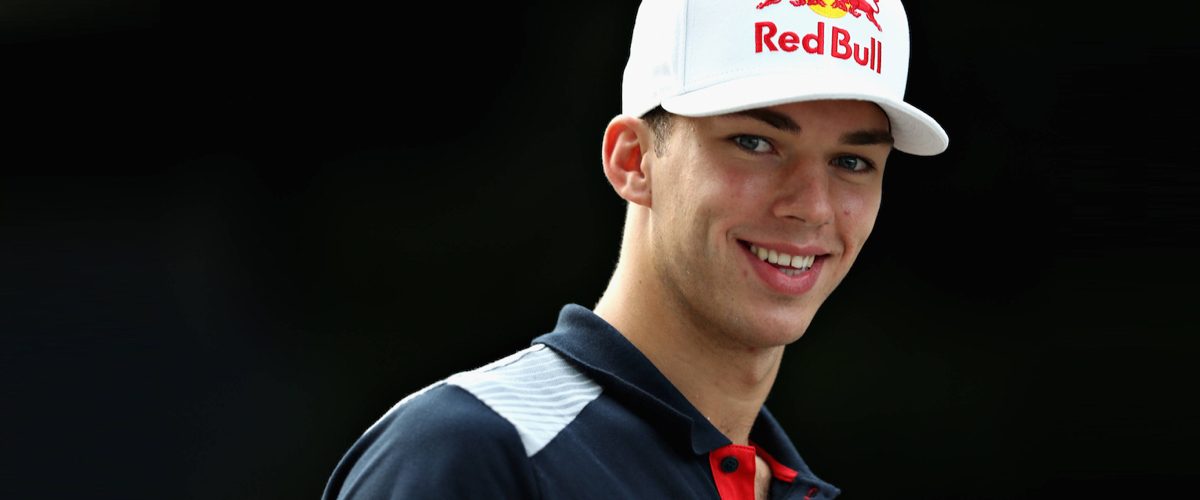Alas, the 2017 race would be the last at the venue for the foreseeable future but also a memorable one both for a Toro Rosso old boy and a brand new addition to the team in exciting young French starlet Pierre Gasly.
It had been announced after the Singapore Grand Prix that Pierre, one of the Red Bull Junior Programme drivers and 2016 GP2 champion, would stand in for Daniil Kvyat in Singapore in order to assess his future potential for the team.
Currently a contender for the Japanese Super Formula series, Pierre looked more like a Formula 1 veteran when he stepped into the cockpit during a tricky wet free practice, lapping quicker than his highly experienced teammate Carlos Sainz during a truncated wet session.
Showing this was no flash in the pan, Pierre again pushed Carlos close during qualifying, lapping quicker again in Q1 and finishing just 0.156s adrift to line up alongside his teammate, 15th on the grid for his debut GP.
A sprinkling of rain before the race must have got the adrenaline coursing through the veins even more with cars starting on slicks on a slippery but drying circuit. But when the lights went out, racing instinct kicked into gear, a bold move on Romain Grosjean at the start keeping him right behind his teammate.
Deciding to stay out on his supersoft compound tyres as Pierre and others others pitted, Carlos found himself running a strong eighth in the early stages and dicing with Esteban Ocon before an unfortunate electrical glitch put paid to his chances of another points finish just over halfway through the race and with a strong finish potentially in the offing.
For Pierre, there were other troubles to contend with, a glitch with his drink system giving him something else to think about whilst racing.
“I tried to do my best and pushed as hard as possible! It was a really physical and tough race – my drink system didn’t work properly, the water was going all over my face and not in my mouth! – and it felt like a long race… But with such a big adrenaline boost that I got, I just kept focusing until the end.”
In completing his debut grand prix for Toro Rosso, young Pierre was following in the footsteps of race winner Max Verstappen and no doubt looking up at the pictures of the podium celebrations and thinking of what may be in the years to come.
Gasly’s mature race drive on his grand prix debut was made all the more impressive due to the little time he had to prepare.
He would have only known for a week or so beforehand that he would be replacing Daniil Kvyat for Malaysia and despite having tested for Red Bull in F1 before, there would be much to learn before Friday’s free practice.
Firstly, he would have to adjust to a new cockpit, steering wheel and pedal position. Usually, his seat fitting would have been done at the beginning of the season back in the factory. This is done by the driver sitting in the car chassis on plastic bags filled with expanding foam which will exactly fit the contours of the driver and internal shape of the tub.
The foam buck is then scanned into 3D CAD software, and the data from that 3D model goes to the tooling block where the seat mould is cut from the tooling block, used to build the lightweight carbon fibre seat.
Seat set-up is crucial in relation to the driver’s feel regarding his pedal travel and steering wheel. Some drivers prefer a stiffer setup with minimal travel and others a softer, longer give for both brake and throttle. Then comes the steering wheel, which, to the casual viewer, may look more like the controls of a jet fighter aircraft than a racing car. With all the dials and knobs combined, there are around 20 buttons and dials to get to grips with – far more than that of a lower formula car.
From adjusting front and rear brake balance, fuel and load settings (to compensate for oversteer or understeer) to selecting tyre compounds and talking to the pits and even the sometimes tricky job of getting a drink. There’s a lot for the driver to think about whilst driving around an F1 circuit at 180mph.
Farewell Malaysia and welcome Pierre. It was a memorable week for everyone involved. From an exciting event on Wednesday where Acronis presented a new version of Acronis Access Advanced used by Scuderia Toro Rosso for secure file sharing to all the action on the Sepang International Circuit on Sunday. Now we are looking forward to the next race in Japan!
Image: Pierre Gasly. © Red Bull Content Pool.



